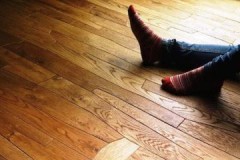Ways and methods of how and with what you can remove stains of various origins at home
 Everyone without exception faces stains. Sometimes it is not difficult to deal with contamination, but sometimes it becomes a cause of headache, as it is firmly embedded in the surface.
Everyone without exception faces stains. Sometimes it is not difficult to deal with contamination, but sometimes it becomes a cause of headache, as it is firmly embedded in the surface.
If fighting it has turned into agony, read the article. It will tell you how to completely remove stains of various origins, including difficult to remove stains.
Content
How to remove using folk remedies?
Almost any stain can be removed using universal household products that can be found in every home. These include:
-
 Laundry soap 72%. This particular bar is made in accordance with GOST, has optimal fat content and effectively copes with various types of stains.
Laundry soap 72%. This particular bar is made in accordance with GOST, has optimal fat content and effectively copes with various types of stains.It can be used not only for fabric, but also for treating hard surfaces. It is most convenient to grind the block into shavings and use them in parts, after diluting them in a small amount of water.
- Hydrogen peroxide. To combat stains, use a solution with a concentration of 3%. This composition can be used to remove old contaminants. Peroxide effectively deals with different types of stains: blood, sweat, grease, deodorant and more.
A pleasant bonus of such cleaning is the bleaching of things. However, use peroxide for washing colored fabrics with caution, keeping contact to a minimum.
- Vinegar. It is effective in combating different types of stains. The acid equally effectively dissolves traces of rust, tape, chewing gum, food and more. To avoid damaging the item, it is recommended to use 9% table vinegar; if the concentration is higher, there is a risk of damaging the item.
- Soda. This is a natural and non-aggressive product that is suitable for treating most surfaces. You can clean furniture and things with soda. It copes well with all types of stains: cosmetics, food, paint, grease, etc.
- Ammonia. This product not only effectively cleans surfaces, but also prevents colored items from shedding. It can be used for any products.
How to remove with household chemicals?
Household chemicals are used to combat stains. Such substances consist of several components, due to which they effectively remove any dirt from various surfaces.
Features of choice:
- People suffering from allergies should give preference to natural-based products. They are also used to care for the belongings of small children and people with hypersensitive skin.
- Products containing chlorine are only suitable for durable fabrics and surfaces with permanent staining.
- A quality stain remover should be free of phosphates.
- Most cleaning agents contain surfactants. The product is considered safe if it contains no more than 30%.
- Enzymes have good cleaning ability. In addition, they are safer to use.
- Regardless of the type of surface, it is better to give preference to liquid products. Abrasive substances leave behind scratches.
Top 3 best lineups.
Eared Nian
Stain remover with a complex of 5 enzymes. The product is available in the form of a spray, suitable for combating stubborn stains, safe for children, does not contain phosphates, chlorine and fragrances. The bottle is equipped with a convenient spray nozzle. Price – 100 rubles.
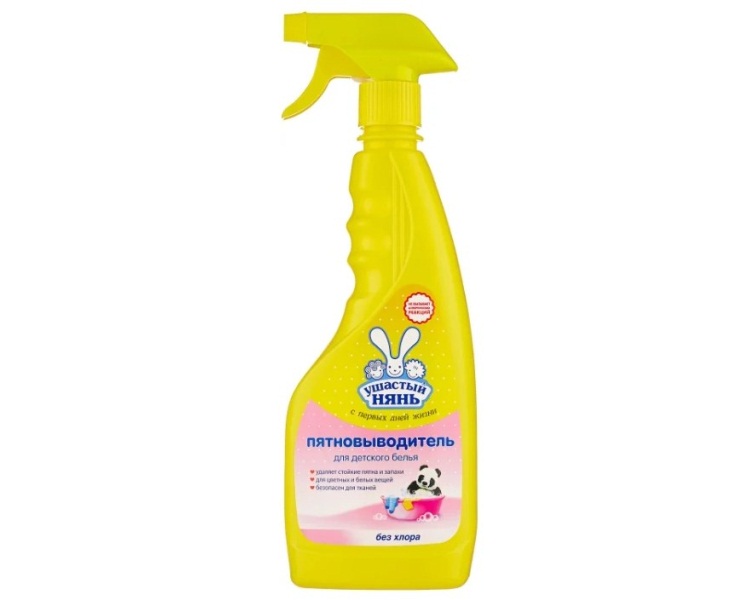
Clean Home
Bleach-stain remover express effect. The composition is available in powder form, is safe for all types of fabrics, does not contain parabens, chlorine and phosphates. Price – 360 rubles.

Paterra
Stain remover for all types of fabrics. The product is available in the form of a concentrate. The composition is universal, it can be used to clean clothes, shoes, upholstered furniture, bags, carpets and more. Price – 350 rubles.

How to deal with pollution?
Any product can leave complex stains on the surface. If regular washing fails to remove them, they resort to pre-treatment with special substances. These can be both folk remedies and household chemicals.
From banana
Banana spots are very unpleasant. They quickly darken and eat deeply into the fibers of the fabric, spoiling the appearance of the item. Laundry soap will help cope with the problem.
Procedure:
- moisturize the stain;
- in a separate container, prepare a slurry from shavings of laundry soap and warm water;
- apply it to the product for an hour;
- Rinse the item in warm water and put it in the wash.
If the stain is old, the procedure will have to be repeated.
From hot on the countertop
Light circles may appear on the countertop and other surfaces on which a hot dish or glass of hot tea has been placed.
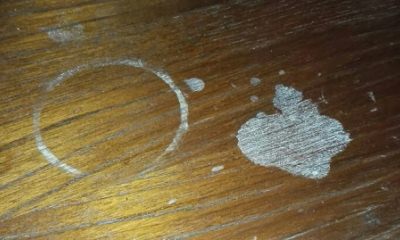 You can get rid of them in the following way:
You can get rid of them in the following way:
- Squeeze a small amount of toothpaste onto the problem area.
- Rub it with a soft brush.
- Wipe the countertop with a clean, damp cloth and let it dry.
If the surface is wooden, it is recommended to clean it with fine abrasive sandpaper, cover it with a coloring compound and varnish.
I also use table vinegar or apple cider vinegar to combat stains. They treat not only the stain itself, but also the adjacent area so that the color of the cleaned area does not differ much from the general background.
From tea
Dark tea stains can be easily removed with baking soda and hydrogen peroxide.
Mode of application:
- moisten the surface to be treated;
- sprinkle it with soda, rub it with a soft toothbrush;
- moisten with peroxide, leave to act for 20 minutes;
- rinse with clean water, wash with stain remover.
From celandine
You can deal with dark yellow traces of celandine using starch.
Procedure:
- If the liquid has dried, the surface is slightly moistened. When the drops are fresh, nothing needs to be done.
- Place the item on a flat surface and sprinkle it generously with starch.
- Cover the powder with a clean, dry cloth and press down with a weight.
- After an hour, the starch is brushed off and the product is washed in a warm soapy solution.
From Cola
 You can deal with traces of Coca-Cola using a strong saline solution.
You can deal with traces of Coca-Cola using a strong saline solution.
Procedure:
- turn on cold water and hold the product under running water for about 5 minutes;
- dilute a strong saline solution - 1 liter of water will require 3 tablespoons of salt;
- soak the item for half an hour;
- wash it using laundry soap or stain remover;
- rinse thoroughly.
Salt will not only remove dirt, but will also refresh the color of the item.
From pomegranate
Bright traces of garnet can ruin light and dark things. A mixture of glycerin and ammonia will help to cope with the problem.
Procedure:
- Prepare the cleaning product: mix 4 teaspoons of glycerin and 1 teaspoon of alcohol in a bowl.
- Leave the composition at room temperature for 60 minutes.
- Soak a clean cotton pad in the solution and rub it into the stain.
- After 30 minutes, wash the product in the usual way.
From bleach
Bleach stains can be removed using an alcohol-containing liquid. Most often, regular vodka is used.
Procedure:
- Rinse the area to be treated under running water. This is done in order to wash away the contamination as much as possible.
- Apply soda slurry to the product, let it dry and brush off.
- Soak a cotton sponge in alcohol and treat the surface.
- If the product is colored, you need to remove the dye from the fabric onto the whitish spot. This will make it less noticeable.
- Wash the item as usual.
It is not possible to deal with the stain the first time, but 2-3 such treatments will allow you to achieve the desired effect.
From potassium permanganate
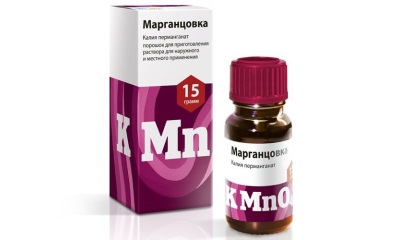 Potassium permanganate stains can be removed with acid. Lemon juice or powdered lemon juice works well for this task.
Potassium permanganate stains can be removed with acid. Lemon juice or powdered lemon juice works well for this task.
Procedure:
- lemon juice is squeezed onto the stain immediately, there is no need to dilute it;
- if citric acid is used, then it is dissolved in a small amount of water until a thick paste is obtained;
- wipe the area with a cotton sponge until it no longer turns pink;
- leave for 15 minutes, after which the item is washed as usual.
If the stain is old, citric acid can be strengthened with a 10% borax solution.
From juice
Juice stains can be easily removed with laundry soap.
Mode of application:
- rub 72% soap into the shavings; to enhance the effect, you can add a small amount of soda;
- mix the dry mass with water to obtain a paste with a consistency reminiscent of sour cream;
- apply it to the contaminated area, leave for 30-40 minutes;
- wash in warm water.
Paraffin
Before proceeding with the main processing, the frozen paraffin protruding above the surface must be carefully cleaned off with the back of the knife.
Then proceed as follows:
- Place the item on a flat surface.
- Cover the stain with a paper towel. Another napkin is placed under the wrong side.
- They go over the napkin with a hot iron, change it for a new one, and repeat the procedure.
- When the paraffin stops imprinting, wash the item in hot water.
Rusty
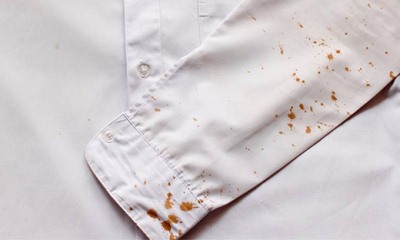 Rusty marks are firmly etched into the surface, which makes them very difficult to deal with. You can spend a minimum of effort and completely remove rust in the following way:
Rusty marks are firmly etched into the surface, which makes them very difficult to deal with. You can spend a minimum of effort and completely remove rust in the following way:
- mix table vinegar and lemon juice in equal proportions;
- pour the mixture into an enamel bowl, heat to 80 degrees;
- soak the contaminated area for 5 minutes;
- rinse with warm water.
If the rust does not appear on the fabric, but on a hard surface, then soak a cotton sponge in a warm solution and wipe it until it is completely clean. After treatment, the area is washed with clean water.
You can learn how to remove rust from clothes here, from white things - Here.
Grass
You can get rid of grass stains using a mixture based on laundry or tar soap with the addition of ammonia.
Procedure:
- Ammonia is mixed with warm water in equal proportions, and the green trace is treated with it.
- Leave for 15 minutes.
- Apply soap slurry to the stain and leave for another half hour.
- Wash the item in warm water.
He will tell you how to wash grass from jeans this article.
Oil
Baking soda in combination with washing powder will help deal with oil stains. Mode of application:
- prepare a cleaning solution based on 1 tablespoon of soda, 1 tablespoon of washing powder and 1 glass of hot water;
- the product is applied to the contaminated area;
- rub the composition with an old toothbrush with soft bristles;
- leave to act for 40 minutes;
- wash the item as usual.
For the product to work, you need to use hot water.
Blood
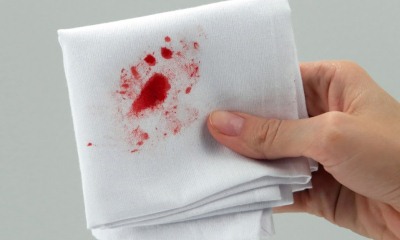 You can get rid of blood stains using hydrogen peroxide. Use it as follows:
You can get rid of blood stains using hydrogen peroxide. Use it as follows:
- Prepare a solution: for 3 tablespoons of peroxide you will need 3 tablespoons of water at room temperature.
- Pour the resulting mixture onto the stain and leave for 25 minutes.
- Wash in cool water, using powder or laundry soap.
- Rinse the product thoroughly and send it to dry.
This will tell you how to remove a blood stain, including an old one. this article.
Bleach
Sometimes bleach not only fails to remove stains, but also causes stains to appear. You can get rid of them in the following way:
- dilute soda with water until it becomes thick sour cream;
- distribute it over the surface of the fabric with a brush;
- leave for 15 minutes, rinse with warm water;
- moisten a cotton swab in nail polish remover and begin to systematically distil the paint from the colored area to the faded one; when the pigment is evenly distributed, stop the procedure;
- wash the item as usual.
Beer
Lemon soda slurry will help deal with stains from spilled beer. The acid will lighten it, and the baking soda will clean the surface.
Mode of application:
- Mix 1 teaspoon each of citric acid and soda, add a small amount of water.
- Apply the product to the yellow mark.
- Leave for 40 minutes.
- Rinse with clean water and scrub with a brush if necessary.
- Wash with powder.
Wine
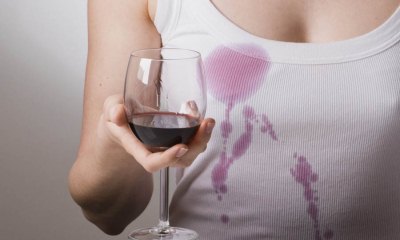 You can get rid of wine stains using laundry detergent and vinegar water. Mode of application:
You can get rid of wine stains using laundry detergent and vinegar water. Mode of application:
- dilute a glass of washing powder in 2 liters of warm water - the solution should be highly concentrated;
- soak the product for 30 minutes or more, if the fabric allows it;
- prepare a vinegar solution in a separate container - 3 tablespoons of vinegar are required for 1 liter of water;
- remove the item from the powder solution, rinse in clean water and soak in vinegar for 15 minutes;
- Rinse the product again and hang it out to dry.
You can learn how to remove red wine from clothes here, from colored things - Here.
Fat
You can get rid of greasy stains with mustard. Procedure:
- Mustard powder is mixed with a small amount of warm water until the lumps are completely dissolved.
- Distribute the composition according to contamination.
- Leave until completely dry, but not less than an hour.
- Clean off the powder with a brush.
- Wash the item in warm water using regular soap or powder.
Read more about removing grease stains Here.
Pen
You can get rid of gel pen marks using table vinegar. Procedure:
- the required amount of acid is poured into an enamel plate and slightly heated;
- moisten a cotton sponge in the composition and wipe the stain;
- wash the product in the usual way.
Ammonia works well with ink from a regular pen. It is used in a similar way to vinegar. Since ammonia has a pungent odor, it is necessary to take care of respiratory protection. Learn more about removing ink stains Here.
Felt pen
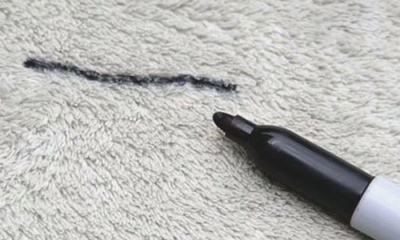 Marks from a felt-tip pen can be easily removed with alcohol. Mode of application:
Marks from a felt-tip pen can be easily removed with alcohol. Mode of application:
- Soak a cotton sponge in alcohol-containing liquid.
- Wipe the stain with it. Processing is stopped only after the pigment stops imprinting on the disc.
- Wash the product as usual.
If the markers are water-based, then traces of them can be removed during a classic wash with pre-treatment of the stain with an industrial stain remover.
Differences in the fight against fresh and old, ingrained marks
Main differences in wrestling with new and old stains:
- fresh stains are easier to remove; sometimes you can get rid of them simply by washing the product with water;
- if the stain has just appeared, it should not be allowed to dry out;
- Granular substances that have the ability to absorb other molecules cope well with fresh contaminants - this can be soda, salt, starch, flour;
- old stains always have to be soaked before the main wash;
- the longer the stain remains on the surface, the more aggressive the product for removing it should be;
- Fresh stains can be dealt with the first time, and old ones can be dealt with in 2-3 procedures.
Removal features depending on surface type
There are features of the fight with stains on different surfaces:
- To clean the fabric, you have to pre-soak it. It is better to use liquid formulations as a cleaning agent. After applying any product, the product is washed to wash out any remaining stain remover or other substance from its fibers.
- Wood can be cleaned using abrasive materials, such as sandpaper. The main thing is to sand the surface thoroughly so that it becomes perfectly smooth.
- Plastic is afraid of contact with sharp objects and aggressive household chemicals. It must be heated carefully, as it may become deformed.
- Metal can be cleaned with sandpaper or a grinder. The main thing is to varnish the surface after removing the stain so that rust does not appear on it. If the metal is painted, it is not advisable to use solvent-based compounds.
Helpful information
Tips for effective stain removal:
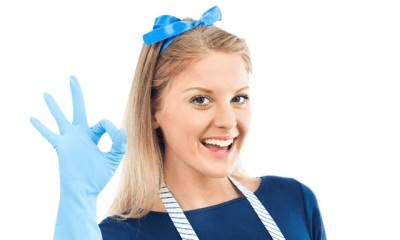 Hydrogen peroxide is used with caution when treating colored items;
Hydrogen peroxide is used with caution when treating colored items;- to enhance the result, you should not mix folk remedies and industrial household chemicals - such a combination can lead to an unpredictable reaction;
- if a substance is used to process an item for the first time, first it needs to be tested in an inconspicuous area;
- If colored fabric is being processed, it is advisable to turn it inside out.
Conclusion
Removing a stain from a surface is not difficult if you know the nature of its origin. For each contaminant, there are compounds that work better than others.The main thing is not to violate the instructions and not to use aggressive means, so as not to completely ruin the thing.


